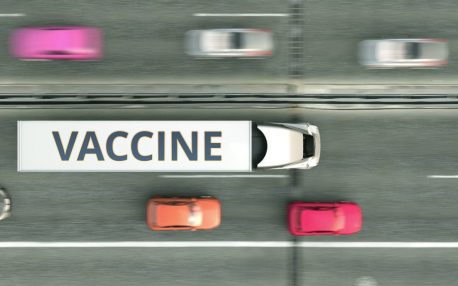
Challenges to an effective rollout of the COVID-19 vaccine.
By: Dr. Anthony Salandy
Date: 7th October 2020
There are a few COVID-19 vaccine candidates in Phase III clinical trials. The FDA and its advisory groups [e.g., Vaccines and Related Biological Products Advisory Committee (VRBPAC)] are working with Pharmaceutical companies to review the data on safety and efficacy. CDC and the Advisory Committee for Immunization Practices (ACIP) also are meeting to review data and recommend practices and protocols for vaccine administration. Jurisdictions are ramping up their distribution, storage, and advocacy activities. Commercial enterprises are being primed to ship and store vaccines. Even though this is a herculean effort, it does come with significant challenges. Below are a few challenges that must be considered prior to the COVID-19 vaccine rollout.
Production Challenges
Manufacturing enough of an FDA approved COVID1-9 vaccine to supply all of the U.S. is a tremendous feat. Ample quantities of the special materials for the vaccine need to be sourced. For instance, glass vials that hold vaccines needs to be secured – as well as squalene that is used as an adjuvant in the leading COVID-19 candidate vaccines.
Recently, Shark Allies – a California-based group , suggests that if the world’s population received the COVID-19 vaccine containing squalene from shark liver, around 250,000 sharks would need to be slaughtered, depending on the amount of squalene used. Shark Allies and others call for the use of non-animal squalene . A number of companies have already scaled up manufacturing capacities for their vaccine candidates. The U.S. government also has stockpiled the leading candidates. Furthermore, the WHO has skirted the issue in a recent report on the landscape of covid-19 vaccine candidates.
Storage and Distribution Challenges
Transporting the COVID-19 vaccine across the U.S. requires a big lift from private and public entities. Recently, Department of Defense officials indicated that military transportation assets will not be needed for distribution since there is sufficient U.S. commercial transportation capacity. The Centers for Disease Control and Prevention (CDC) has selected McKesson Corp. as the centralized distributor of COVID-19 vaccines. McKesson Corp. will coordinate commercial logistic activities with other industry partners, such as FedEx Express and UPS. Moreover, state governors were asked by CDC in August to coordinate with McKesson to set up vaccine distribution facilities so they are operational by Nov. 1.
Along with developing transportation capacity, individuals are securing storage units for the vaccine. Moderna and a Pfizer-led team said recently that their vaccines are so fragile they need to be frozen at temperatures up to minus 80 degrees Celsius — below the capability of most freezers. To put that in perspective, most home and commercial freezers operate at minus 17 degrees Celsius or 0 degrees Fahrenheit.
The Pfizer vaccine is nearly impossible to maintain at the required temperature during transit, so the company has developed special thermal containers that can keep vaccines frozen for up to 10 days but have limited capacity. Once opened, the containers need to be quickly refreshed with dry ice.
Because of storage limitations, state health officials are concerned about how to ship the vaccine to rural communities without any significant temperature changes. Rural hospitals don’t have the required freezers for proper vaccine storage. One way to address these challenges would be to remove some doses from a bulk allocation to an urban center, repack it in dry ice and drive it to rural clinics. Alternatively, community health center in rural areas and on reservations can begin purchasing minus 80 degrees Celsius freezers. There is also a bit of staff training as well as infrastructure design that is needed for minus 80 degrees Celsius freezers. These freezers tend to get very hot, needs to be in an area with very good ventilation and have backup generator power.
Financial challenges
States will need financial support from the U.S. federal government in order for the COVID-19 vaccination program to be a success. Some U.S. officials say an estimated $6 billion in additional money is needed to help states prepare for the rollout. Still, vaccine education, advocacy and campaign expenses are likely to pale in comparison to the cost of the pandemic: an estimated $375 billion a month globally. Moreover, the actual out-of-pocket cost to individual Americans may be nominal albeit “tax payer” money is paying for most of the overall cost. The U.S. Department of Health and Human Services (HHS) indicated publicly that an approved COVID-19 vaccine will be free “to the American people.” That includes everyone, regardless of age, income, or the type of health plan you have.
However, your healthcare provider will be allowed to charge insurers for the cost of administering the COVID-19 vaccine. That’s normal with vaccines purchased by the government. Healthcare providers may see overhead cost in storage, distribution, and loss due to waste and errors that are not reimbursable.
Two-shot challenges
The COVID-19 vaccine rollout is made significantly more complicated because most approaches require two shots – initial vaccine then a booster shot. This exponentially increases the manufacturing, storage, and transport difficulty. Johnson & Johnson and rival Merck & Co. are betting on one-shot vaccines, which could give them a distribution edge. We know from experience with other double-shot vaccines that a large number of individuals do not return for the 2nd shot. Data from two-shot COVID-19 vaccines will have to clearly indicate if the efficacy and immunogenicity of the vaccine is at all impacted. On October 8th 2020, the FDA released guidance on criteria needed for Emergency Use Authorization for COVID-19 Vaccine candidates. One requirement is that companies request EUA must provide data from Phase 3 studies should include a median follow-up duration of at least two months after completion of the full vaccination regimen to help provide adequate information to assess a vaccine’s benefit-risk profile. This could provide information about the safety and efficacy of the vaccine in individuals who may only receive one dose.
Security challenge
One lesson of H1N1 epidemic is when vaccine supply was more plentiful, people were less likely to want it. Demand skyrocketed when the H1N1 vaccine was scarce. Amid expectations of huge demand and limited supply, there is concern vaccines could be diverted illegally. Recognizing this challenge, the Vaccine Tracking System (VTrckS) , a critical component of the Vaccine Management Business Improvement Project (VMBIP) was developed with support from CDC.
VTrckS is a secure, web-based information technology system that integrates the entire publicly-funded vaccine supply chain from purchasing and ordering through distribution to participating state, local, and territorial health departments (referred to as ‘awardees’) and health care providers.
Additionally, the VTrckS ExIS (External Information System) interface is a means for awardees and health care providers to process vaccine requests by uploading data from their Immunization Information System (IIS) to VTrckS.
When the COVID-19 vaccine is approved, an expansive logistics operation will need to be primed and ready. Many of these challenges will have to be worked out or at least a strategy in place to address them.

Anthony Salandy, Ph.D., M.S.
Dr. Salandy is founder of the Institute for COVID-19 Vaccination Advocacy (ICVA). ICVA aims to increase knowledge of the COVID-19 vaccination program, decrease COVID-19 vaccine hesitancy, and improve COVID-19 vaccine coverage around the globe.